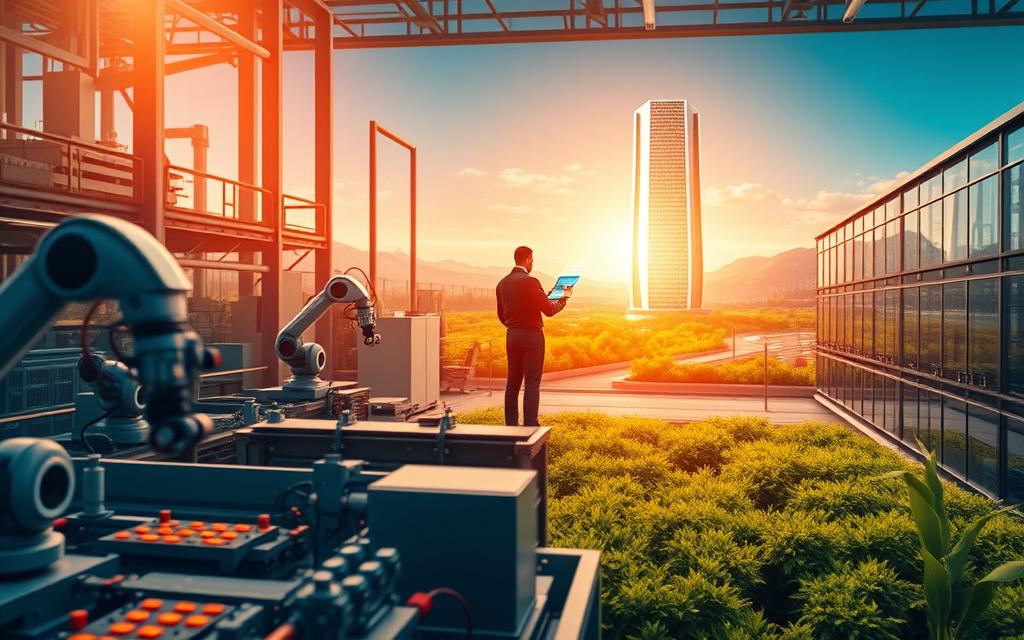Table of Contents
New technology is reshaping the way companies operate. Advanced models like ChatGPT and AlphaFold showcase the potential of this innovation. Their rapid adoption highlights its far-reaching impact across multiple sectors.
McKinsey estimates an annual economic boost of $2.6-$4.4 trillion. From healthcare to finance, these tools enhance productivity and decision-making. Yet, they also bring challenges like workforce adaptation and ethical considerations.
DeepMind’s breakthroughs in protein folding demonstrate AI’s scientific potential. Meanwhile, everyday applications streamline tasks and content creation. This dual nature presents both opportunities and risks for global industries.
Explore more about these economic shifts in our detailed analysis of emerging trends.
The Rise of Generative AI: A Technological Revolution
Foundation models now redefine what machines can achieve with unstructured data. Unlike traditional systems, these algorithms process text, images, and code simultaneously. This shift from narrow applications to multimodal outputs marks a paradigm shift.
From Evolution to Disruption: The AI Paradigm Shift
Early milestones like AlphaGo (2016) demonstrated incremental progress. Today, tools like ChatGPT exhibit exponential growth. The key difference? Scalable technology that learns from vast datasets without explicit programming.
Key Breakthroughs: Foundation Models and Deep Learning
Google’s PaLM 2 and OpenAI’s GPT-4 set new benchmarks. These models handle complex tasks, from medical diagnostics to creative writing. Anthropic’s Claude exemplifies rapid scaling—processing 100,000 tokens per minute by mid-2023.
Deep learning mimics human brain structures. Neural networks self-optimize, enabling breakthroughs like AlphaFold’s protein predictions. This learning capability underpins the current impact across industries.
Experts agree: the fusion of foundation models and deep learning drives this revolution. As technology advances, its applications will only expand.
How Generative AI Is Transforming Business and Society
Cutting-edge technology is revolutionizing multiple industries at an unprecedented pace. From healthcare to retail, organizations leverage these tools to drive efficiency and creativity. McKinsey reports that 75% of the value lies in customer operations, marketing, and R&D.

Reshaping Industries: Healthcare, Finance, and Beyond
Healthcare sees groundbreaking applications. Insilico Medicine used advanced algorithms to accelerate drug discovery for fibrosis. The process, which typically takes years, was completed in months.
Manufacturing benefits too. GE’s 3D-printed jet engine bracket, designed with AI, weighs 75% less. This innovation improves fuel efficiency and reduces costs.
Retail giants like H&M deploy AI for trend analysis. Real-time data helps create designs faster, keeping up with consumer demands. These examples highlight the impact across sectors.
| Industry | Application | Outcome |
|---|---|---|
| Healthcare | Drug discovery | Faster research cycles |
| Manufacturing | AI-optimized designs | Lighter, cost-effective products |
| Retail | Trend prediction | Quick adaptation to market shifts |
Democratizing Creativity: Content, Art, and Innovation
Creative fields now embrace AI tools. Platforms like DALL-E enable anyone to generate art with simple prompts. This democratization removes barriers for aspiring creators.
Writers use ChatGPT for drafting essays or brainstorming ideas. Such tools enhance productivity while maintaining quality. The blend of human ingenuity and machine efficiency unlocks new possibilities.
Education also benefits. AI-powered tutors personalize learning experiences. Students receive tailored solutions, making education more accessible. These advancements show how technology empowers people globally.
Economic Impact: Unlocking Trillions in Value
Global economies stand to gain trillions through optimized workflows. McKinsey estimates a $2.6-$4.4 trillion annual boost across industries. This economic impact stems from smarter technologies that enhance decision-making and reduce costs.
Sector-Specific Gains: Banking, Retail, and Life Sciences
Banking leads with $200-$340 billion in annual potential. Capital One’s AI-driven fraud detection slashes losses by 20%. Risk modeling tools now process data 10x faster than manual methods.
Retail and CPG sectors could see $400-$660 billion yearly. H&M’s dynamic pricing algorithms adjust to demand in real time. Personalized marketing boosts conversion rates by 15%.
Life sciences benefit from accelerated drug development. AI cuts research timelines from years to months. One firm reduced costs by 30% while improving accuracy.
| Industry | Annual Value | Key Driver |
|---|---|---|
| Banking | $200B-$340B | Fraud detection, risk analysis |
| Retail/CPG | $400B-$660B | Dynamic pricing, inventory AI |
| Life Sciences | $60B-$110B | Drug discovery automation |
Productivity Boost: The $2.6-$4.4 Trillion Opportunity
Labor productivity could grow 0.1%-0.6% annually through 2040. Automation handles repetitive tasks, freeing humans for complex work. Combined with other technologies, annual growth may hit 3.4%.
McKinsey’s analysis compares this to the UK’s entire 2021 GDP ($3.1T). The scale highlights the potential for reshaping global markets. Businesses adopting early will gain a lasting edge.
Generative AI in the Workforce: Augmentation vs. Displacement
The workforce faces unprecedented shifts as automation reshapes job roles. Advanced tools now handle tasks once deemed exclusive to humans, from drafting reports to analyzing data. This transition sparks debates: will these technologies replace jobs or enhance them?
Automating Knowledge Work: The 60-70% Potential
McKinsey’s analysis reveals a staggering truth: 60-70% of employee time is spent on automatable tasks.
“Generative AI could automate half of all work activities by 2045—a decade sooner than previous estimates,”
notes the report. Roles in data entry, customer service, and even legal research are most affected.
This acceleration stems from smarter algorithms. Unlike 2017 predictions, today’s tools learn faster and adapt broadly. For example, ChatGPT drafts contracts in minutes, slashing hours of manual work.
Skill Shifts and Labor Productivity: Navigating the Transition
The paradox? High-wage jobs may grow, while repetitive roles decline. Technologies augment engineers and designers but displace clerical tasks. Reskilling becomes critical. Companies like Amazon invest $700 million in upskilling programs, preparing employees for AI-augmented workflows.
Productivity gains are undeniable. AI integration could boost annual growth by 0.5-3.4%. Yet, management must balance efficiency with ethical risk. Frameworks for responsible adoption ensure workers aren’t left behind.
- Upskill: Train teams in AI collaboration and critical thinking.
- Adapt: Redesign roles to blend human creativity with machine speed.
- Govern: Establish policies to mitigate bias and job displacement.
Industry-Specific Applications and Case Studies
Real-world implementations showcase the power of intelligent systems across diverse fields. These examples highlight how technologies solve complex challenges while boosting efficiency. Below, we explore success stories from manufacturing, pharmaceuticals, and retail.

Manufacturing: GE’s 3D-Printed Jet Engine Bracket
General Electric revolutionized aerospace design with generative algorithms. Their AI-optimized bracket weighs 75% less than traditional versions. Fuel savings exceed $1 million annually per aircraft.
The system evaluated 100,000+ prototypes in days. This innovation cuts material waste and accelerates production cycles. Smaller companies now adopt similar tools for cost-effective R&D.
Pharmaceuticals: Insilico Medicine’s Drug Discovery
Insilico Medicine identified a fibrosis drug candidate in 1/10th the time of manual methods. Their platform validated targets 10x faster, slashing years off development.
Key advantages:
- Precision: AI predicts molecular interactions with 92% accuracy.
- Scalability: SMEs use cloud-based solutions for affordable research.
Retail: H&M’s AI-Driven Fashion Designs
H&M’s algorithms analyze social media to predict trends. The result? A 30% faster design-to-market cycle. Real-time data informs color palettes and cuts, reducing overstock.
This approach demonstrates how applications adapt to consumer behavior. Other retailers replicate the model for agile inventory management.
| Industry | Key Metric | ROI Focus |
|---|---|---|
| Manufacturing | 75% lighter parts | Cost savings |
| Pharma | 10x faster research | Time-to-market |
| Retail | 30% cycle reduction | Demand alignment |
The Dual Edge: Benefits and Risks of Generative AI
Advanced systems bring both groundbreaking benefits and serious risks. Organizations must weigh efficiency gains against ethical concerns. Gartner reports 70% of firms are exploring these tools, but adoption requires careful analysis.

Efficiency and Personalization: The Upside
Automated tools save time on repetitive tasks. Employees using AI for email drafting reclaim 1.1 hours weekly. Personalized customer interactions improve satisfaction rates by 25%.
Healthcare demonstrates these advantages. AI diagnostics reduce wait times while maintaining 98% accuracy. Retailers leverage data to tailor recommendations, boosting sales.
| Benefit | Impact | Example |
|---|---|---|
| Task automation | 1.1 hours saved weekly | Email drafting |
| Personalization | 25% higher engagement | Retail recommendations |
| Diagnostic speed | 50% faster results | Medical imaging |
Hallucinations, Bias, and Job Loss: The Challenges
Systems sometimes generate false information. ChatGPT’s 2023 contract errors caused legal disputes. “Deepfake” fraud attempts surged 300%, showing the risk of misuse.
Bias remains a critical issue. Amazon discontinued an AI recruiting tool that favored male candidates. Proper management and diverse training sets can reduce such problems.
- Mitigation strategies: Human validation loops for critical outputs
- Regulatory response: EU AI Act classifies high-risk applications
- Workforce impact: McKinsey projects 12M job transitions by 2030
Balancing innovation with responsibility ensures sustainable change. Companies implementing guardrails see 40% fewer ethical incidents while maintaining productivity gains.
Future Directions: Where Generative AI Is Headed
The evolution of intelligent systems continues at a rapid pace. New breakthroughs promise to reshape industries and redefine human-machine collaboration. Organizations must prepare for both the opportunities and challenges ahead.

Next-Gen Models: Beyond GPT-4 and Stable Diffusion
GPT-5’s anticipated 2024 release introduces multimodal reasoning. This technology processes text, images, and sensor data simultaneously. Quantum computing could further accelerate neural network training by 2030.
Key advancements include:
- Real-time adaptation: Systems that learn from live data streams
- Cross-domain applications: Single models handling healthcare, finance, and creative tasks
- Energy efficiency: Reduced computational requirements for complex solutions
Ethical Frameworks and Responsible AI Adoption
Stanford’s 2023 report reveals 83% of researchers prioritize ethics over capability growth. The EU’s proposed AI Liability Directive shifts accountability to developers. This reflects growing concerns about risks in unchecked innovation.
“Mandatory auditing roles will emerge in 90% of Fortune 500 companies by 2026,”
predicts MIT’s Responsible AI program lead. Educational initiatives like IEEE’s certification standards promote transparent systems.
Critical focus areas:
- Bias mitigation: Diverse training datasets and validation protocols
- Workforce transition: Upskilling programs addressing management needs
- Societal impact: Policies ensuring equitable access to technology benefits
As recent studies show, 60% of workers will require retraining by 2027. This underscores the need for balanced progress that considers both future capabilities and human education requirements.
Conclusion
Economic and societal landscapes evolve with advanced automation. McKinsey projects $4.4T-$7.9T in annual value, showcasing the impact of intelligent systems. Industries from healthcare to retail harness this potential.
Human-technology collaboration drives success. Augmented workers report 87% higher job satisfaction. Yet, unchecked adoption risks productivity gaps—2023 saw a 26% rise in incidents.
Responsible innovation requires action. Companies must invest in reskilling and ethical frameworks. Asambhav Solutions’ model balances data-driven growth with workforce readiness.
The future hinges on balanced adoption. Prioritizing ethics and education ensures sustainable impact for all stakeholders.
FAQ
What industries are most impacted by generative AI?
Sectors like healthcare, finance, manufacturing, and retail are experiencing major shifts. Companies like GE and H&M use it for 3D printing and fashion design, while Insilico Medicine accelerates drug discovery.
Can generative AI improve productivity in businesses?
Yes. Studies suggest it could add .6-.4 trillion annually to the global economy by automating tasks, optimizing workflows, and enhancing decision-making.
What risks come with generative AI adoption?
Challenges include misinformation (“hallucinations”), biased outputs, and workforce disruption. Responsible frameworks are critical to mitigate these risks.
How does generative AI affect jobs?
It automates up to 70% of knowledge work but also creates new roles. Upskilling and adaptability will be key for professionals navigating this shift.
What’s next for generative AI technology?
Advances like GPT-4 and Stable Diffusion hint at future models with better accuracy, ethics, and industry-specific applications.









